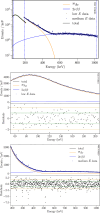Searches for new physics below twice the electron mass with GERDA
- PMID: 39309033
- PMCID: PMC11410851
- DOI: 10.1140/epjc/s10052-024-13020-0
Searches for new physics below twice the electron mass with GERDA
Abstract
A search for full energy depositions from bosonic keV-scale dark matter candidates of masses between 65 and 1021 keV has been performed with data collected during Phase II of the GERmanium Detector Array (Gerda) experiment. Our analysis includes direct dark matter absorption as well as dark Compton scattering. With a total exposure of 105.5 kg years, no evidence for a signal above the background has been observed. The resulting exclusion limits deduced with either Bayesian or Frequentist statistics are the most stringent direct constraints in the major part of the 140-1021 keV mass range. As an example, at a mass of 150 keV the dimensionless coupling of dark photons and axion-like particles to electrons has been constrained to and at 90% credible interval (CI), respectively. Additionally, a search for peak-like signals from beyond the Standard Model decays of nucleons and electrons is performed. We find for the inclusive decay of a single neutron in Ge a lower lifetime limit of years and for a proton years at 90% CI. For the electron decay a lower limit of years at 90% CI has been determined.
Supplementary information: The online version contains supplementary material available at 10.1140/epjc/s10052-024-13020-0.
© The Author(s) 2024.
Figures












References
-
- M. Pospelov, A. Ritz, M.B. Voloshin, Bosonic super-WIMPs as keV-scale dark matter. Phys. Rev. D 78, 115012 (2008)
-
-
M. Agostini et al. (Gerda), First search for bosonic superweakly interacting massive particles with masses up to 1 MeV/
 with Gerda. Phys. Rev. Lett. 125, 011801 (2020). [Erratum: Phys. Rev. Lett. 129, 089901 (2022)]
-
PubMed
with Gerda. Phys. Rev. Lett. 125, 011801 (2020). [Erratum: Phys. Rev. Lett. 129, 089901 (2022)]
-
PubMed
-
M. Agostini et al. (Gerda), First search for bosonic superweakly interacting massive particles with masses up to 1 MeV/
-
- Y.J. Ko, H. Park, Remarks on bosonic super-WIMP search experiments. Phys. Rev. D 104, 083030 (2021)
-
- Y. Hochberg, B. von Krosigk, E. Kuflik, T.C. Yu, Impact of dark Compton scattering on direct dark matter absorption searches. Phys. Rev. Lett. 128, 191801 (2022) - PubMed
-
- J. Heeck, V. Takhistov, Inclusive nucleon decay searches as a frontier of baryon number violation. Phys. Rev. D 101, 015005 (2020)
LinkOut - more resources
Full Text Sources
Research Materials
